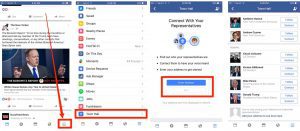 The world has changed. Maybe you like it better now; maybe you don’t. In either case, most people are feeling a bit out of sorts as we observe how things have changed and consider how to recalibrate to interface with the new reality.
The world has changed. Maybe you like it better now; maybe you don’t. In either case, most people are feeling a bit out of sorts as we observe how things have changed and consider how to recalibrate to interface with the new reality.
Of course, it’s not just about how changes occur in the political landscape. It’s also about rapidly evolving mechanisms for online engagement. Consider how Twitter fundamentally altered communication in the lead-up to the 2016 Presidential election.
Facebook has joined the revolution. Facebook recently unveiled a new tool called Town Hall that allows users to contact their elected officials in one click. This answers the question, “what is a town hall meeting”, in a very different way. On a desktop, just visit the Town Hall site and enter your address. Facebook will instantly determine who your elected officials are. Then it is up to you to decide to follow your elected officials.

If using your smartphone, simply click the menu and find the Town Hall logo under apps.
If you decide you are not interested in following someone, go to that individual’s Facebook page and stop following them.
So – public participation practitioners, here’s a question for you. Consider the International Association for Public Participation (IAP2) Spectrum. Facebook is undeniably effective at sharing information and provides one mechanism for soliciting input from the public at IAP2’s defined Consult Level. Go visit one of your elected officials and check out the commentary. I just checked one of my Colorado senators, Cory Gardner, and found a conversation about climate change. Back and forth, and hardly a respectful dialogue.
Can you envision accomplishment of public involvement using Facebook at IAP2’s defined Involve Level? What’s missing?
What other online engagement tools are out there? Are there any that have the capability of engaging the public beyond IAP2’s defined Consult Level? What’s emerging? What is a town hall meeting, anyway? The times are changing.
Author: Wendy Lowe
